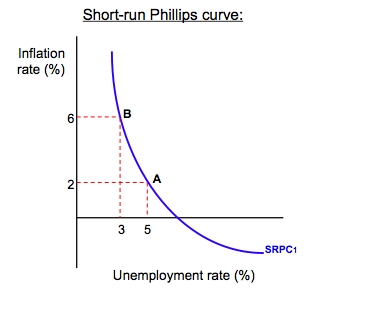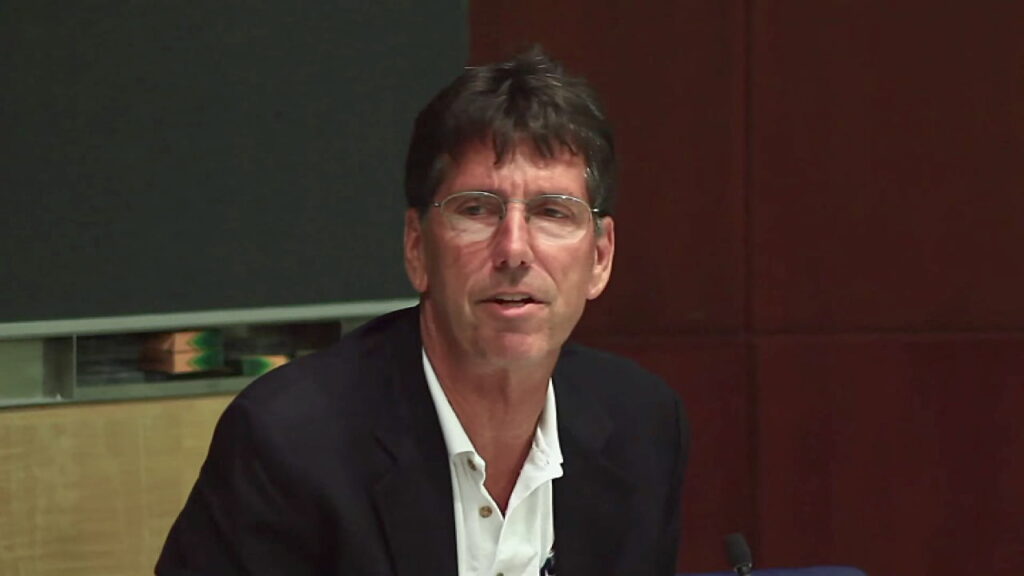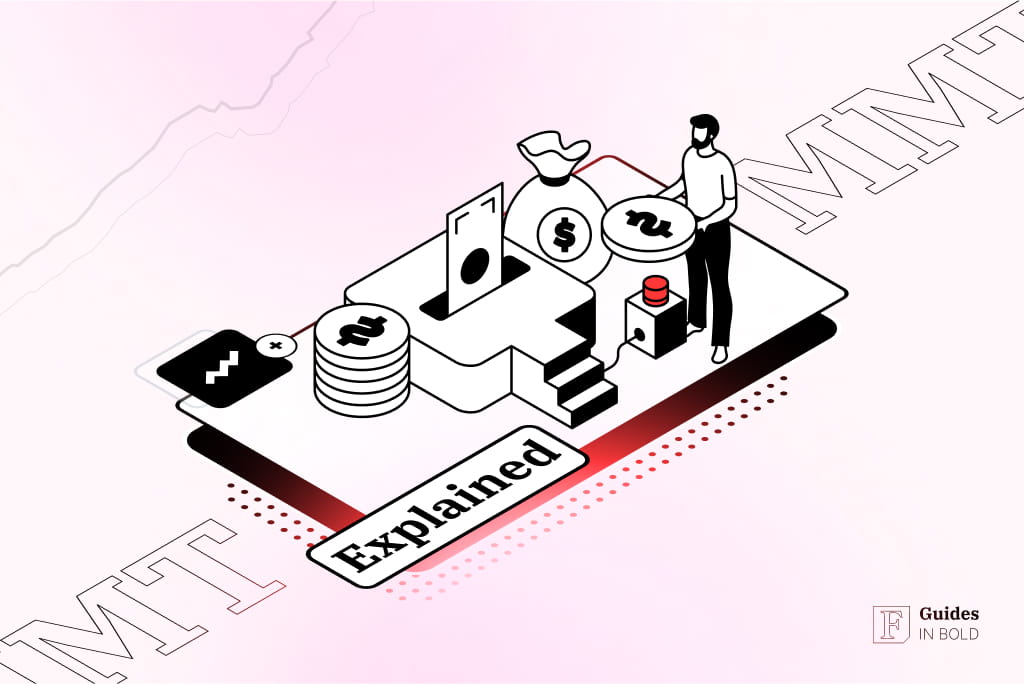Modern monetary theory (MMT) is an unconventional macroeconomic theory that challenges traditional economic views. It suggests that countries with strong economies and their own currencies, such as the United States, can essentially print money without worrying about accumulating debt. Despite facing criticism from conservative economists, MMT has gained support from a vocal group of proponents. In this article, we’ll explore the key principles of modern monetary theory, highlight its differences from mainstream economic thinking, and examine the reasons behind its growing prominence in recent years.
Highly Rated Stock Trading & Investing Platform
-
Invest in stocks, ETFs, options and crypto
-
Copy top-performing crypto-traders in real time, automatically.
-
0% commission on buying stocks - buy in bulk or just a fraction from as little as $10. Other fees apply. For more information, visit etoro.com/trading/fees.
-
eToro USA is registered with FINRA for securities trading.
Modern monetary theory explained
In other words, fiscally independent nations with large economies, such as the United States, the United Kingdom, Canada, and Japan, can print as much money as they need without fearing the consequences of high national debt.
To illustrate, the proponents point out that a country’s budget is unlike a household’s. While an individual can go into default, a country with its debt declared in its currency cannot default, as it would mean that the government should forfeit its assets to itself. Therefore, a country cannot default on debt declared in its own currency.
Recommended video: Why the US is always hitting a “debt ceiling”
There are many points of contention between mainstream schools and modern monetary theory, including opposing views on loans, deposits, government spending, and taxes. But first, we should discuss the origins and context in which this radically unorthodox view of macroeconomics emerged.
Central principles of modern monetary theory
The fundamental principle behind modern monetary theory is that, in practice, countries with their own currencies cannot go into bankruptcy or become insolvent unless the government decides so.
While the mainstream economic theories find increased public spending fiscally irresponsible due to ballooning debt and rising inflation, the MMT finds it not only harmless but desirable.
Many of the principles of modern monetary theory were proposed in economic books written by prominent MMT advocates such as Warren Mosler and Randall Wray.

“Demand originates with the state. Without state spending, the value of the currency is unspecified and there is no aggregate demand. Only subsequent to state spending can the currency obtain absolute value and non-government spending take place.”
― Warren Mosler, Modern Monetary Theory: Key Insights, Leading Thinkers
According to modern monetary theory:
- Large economies like the United States and Japan can have massive deficits without significant consequences;
- High government debt does not lead to financial collapse as the mainstream economists made the people believe;
- Fiscal surpluses and even small deficits pose grave hazards and lead to recessions, as deficit spending boosts individuals’ savings;
- Debt is the money the government injected into the economy without taxing it back;
- Government bonds are not a funding device but a monetary policy device.
Addressing mainstream monetary theory’s aversion to high spending, supporters of MMT claim that while inflation is a theoretical possibility, the risk is negligible, and simple policy decisions could ultimately avert it.
Recommended video: What is Modern Monetary Theory?
Government-made money
Virtually every conventional monetary philosophy follows that taxes represent the government’s means to obtain funds for infrastructure, education, social programs, and other public projects.
Conversely, modern monetary theory regards taxes as mere tools for creating a demand for currency and removing excess money from an overextended economy.
Modern monetary theory observes the macroeconomics paradigm from a whole other viewpoint. Where traditional economics tries to answer a two-body problem, MMT redefines the structure to a triangle solution. The classical theory is simple: the input is taxes, the output is spending, and ideally, both should be equal.
In MMT, taxes and spending are no longer a factor, as independent economies can print their own money. Therefore, spending must be encouraged as a tool to balance the triangle of the macroeconomy:
- (Un)employment
- Inflation
- Domestic production investment
For example, the Phillips curve explains the conventional view on short-term relationship between inflation and unemployment:

On the contrary, MMT provides long-term fiscal policy solutions that preserve low inflation at zero unemployment rate, or full employment, as long as the spending does not surpass the actual capacity and the public investment goes into domestic production.
The only case in which inflation surges is when the government spends more than it has in available resources. The sole factor that policy-makers need to take into account is the tangible goods and available specialists and workers required for the task.
“The government doesn’t want dollars; it wants something else. It wants to provision itself. The tax isn’t there to raise money. It’s there to get people working and producing things for the government.”
― Warren Mosler in Stephanie Kelton’s The Deficit Myth
Furthermore, according to modern monetary theory, unemployment occurs when the government spends too little while collecting taxes. To circumvent unemployment, the government should fund guaranteed minimum-wage transition jobs until an individual finds a position in the private sector. Additionally, the measure would help the country manage inflation in the economy.
The differences between MMT and traditional monetary theories
Even though there is no complete consensus among the thinkers of modern monetary theory, and there are various schools of economic thought that could fit the “conventional” money theory, we can extract a list of key differing points between MMT and the currently established views on mainstream economic viewpoints:
| MMT | Mainstream | |
| Government spending | Governments with sovereign control over their currency (such as the United States) can have their central banks print money to fund spending without debt constraints. The focus is on managing inflation rather than worrying about budget deficits. | Governments need to balance budgets, reduce deficits, and manage debt to maintain fiscal responsibility and economic stability by introducing taxes and issuing bonds. |
| Creating money | The money is created when the government spends and destroyed when it collects taxes. Taxes primarily drive the demand for currency. | Governments receive money through taxes and borrowing. The central bank needs to repay its debt with interest. |
| Central banks | The central bank’s primary role is controlling inflation and maintaining price stability, while fiscal policy is responsible for the active management of economic output and employment. | Central banks are crucial in controlling both inflation and unemployment through monetary policy, including interest rate adjustments. |
| Interest rates | Interest rates should be near zero to encourage economic activity. Fiscal policy, rather than monetary policy, is the primary tool for managing the economy. | Central banks’ interest rate adjustments and open market operations are the primary tools for influencing economic activity. |
| Budget deficit | Budget deficits are not inherently problematic and can be used strategically to address economic challenges, emphasizing maintaining price stability. | Budget deficits should be avoided due to concerns about long-term sustainability and potential adverse effects on interest rates and inflation. |
Key influences on modern monetary theory
Although a relatively recent phenomenon, modern monetary theory traces its roots in older economic ideas, such as chartalism, functional finance, and the credit theory of money.
Chartalism, devised in 1905 by German economist Georg Friedrich Knapp, claims that money is an extension of the state rather than a solution to barter. Furthermore, Knapp wrote that “money is a creature of law” rather than a commodity.
Functional finance is an economic thought spearheaded by Abba P. Lerner that states the government has to finance itself to accomplish specific goals, like balancing the business cycle, decreasing inflation, expanding the market, and achieving full employment.
The credit theory of money, formulated by Alfred Mitchell-Innes, opines that in a currency not backed by a commodity like gold, money and debt (credit) are the same thing observed from a different angle.
Highly Rated Stock Trading & Investing Platform
-
Invest in stocks, ETFs, options and crypto
-
Copy top-performing crypto-traders in real time, automatically.
-
0% commission on buying stocks - buy in bulk or just a fraction from as little as $10. Other fees apply. For more information, visit etoro.com/trading/fees.
-
eToro USA is registered with FINRA for securities trading.
The founders of modern monetary theory
While modern monetary theory draws inspiration from multiple schools of thought and has several influential thinkers associated with it, Warren Mosler is widely credited with establishing the MMT.

Warren Mosler is an American economist, entrepreneur, and hedge fund manager known as a co-founder of the Center for Full Employment And Price Stability and the founder of Mosler Automotive. Mosler received his first insights that would later form the basis of the MMT while working as a Wall Street trader in the 1970s.
When Mosler tried to disseminate his theory, the academic world largely ignored him. It was not until 1993, when he published an essay titled “Soft Currency Economics” online, that he found an audience, including fellow economist Bill Mitchell, another vital developer of modern monetary theory.
The fringe macroeconomics school of thought soon gained prominence on the Internet as more economists joined the discussion on blogs, discussing ideas like a trillion-dollar coin and sharing supporting material, including a video clip of former Federal Reserve Chairman Alan Greenspan claiming “nothing prevents the federal government from creating as much money as it wants”.
Besides Warren Mosler and Bill Mitchell, Randall Wray, Stephanie Kelton, and Pavlina Tcherneva were among the economists who joined and shaped the movement. Politicians like Alexandria Ocasio-Cortez and Bernie Sanders also espoused the MMT. Notably, Stephanie Kelton, often seen as the face of the MMT today, became Sanders’ foremost economic adviser during his 2016 presidential run.

Kelton’s book on modern monetary theory, The Deficit Myth, became a New York Times non-fiction bestseller in 2020.
“The debt isn’t the reason we can’t have nice things. Our broken thinking is. To fix our broken thinking, we need to overcome more than just an aversion to big numbers with the word debt attached. We need to beat back every destructive myth that hobbles our thinking.”
― Stephanie Kelton, The Deficit Myth: Modern Monetary Theory and the Birth of the People’s Economy
Recommended video: Stephanie Kelton: The big myth of government deficits
Mosler’s law
One of Warren Mosler’s critical contributions to modern monetary theory is Mosler’s law. Concerning fiscal policy during a recession, it states that “no financial crisis is so deep that a sufficiently large fiscal adjustment cannot deal with it.”
Mosler is against high taxes as they disincentivize consumption within an economy. Still, he agrees a minimum tax level is needed to guarantee citizens use the currency or, in the case of the U.S., the dollar.
Furthermore, he maintains that inflation is not a factor as long as there is sufficient actual resource capacity, and he is confident in the government’s innate ability to increase spending and guarantee demand and growth constantly. Any debt passed on to successive generations will never be a burden since society tends to consume whatever it produces.
Ultimately, Mosler believes that tax revenues do not limit federal spending, as the government can always make payments in its currency.
“Federal Government checks don’t bounce.”
― Warren Mosler
Modern monetary theory flaws
Critics of modern monetary theory deem it naive at best and irresponsible at worst. A 2019 survey of leading economists by the University of Chicago showed a unanimous rejection of MMT’s basic assumptions.
Paul Krugman, the economist and Nobel laureate whose views on the American debt are similar to those of modern monetary theory, has nonetheless strongly opposed it, warning that implementing it would lead to hyperinflation.
Thomas Palley, the post-Keynesian economist, accused modern monetary theory of “over-simplistic analysis” and understating the dangers of its policies. He further said these measures would financially destabilize an open economy with flexible exchange rates, while fixed exchange rates would impose limits on the government’s sovereign currency.
In short, the criticisms usually come from the established academia and traditional schools of thought, and in general, boil down to:
- Inflation concerns: Excessive government spending without a corresponding productivity increase would cause exponential inflation growth;
- Interest rates and monetary policy: Traditional theories stress the central bank’s role in controlling interest rates to manage inflation. MMT’s approach could reduce the effectiveness of traditional monetary policy tools, as interest rates may be less effective in controlling inflation if fiscal policy dominates.
- Long-term consequences: MMT could encourage policymakers to overspend without considering the long-term consequences. Excessive reliance on monetary financing can lead to unsustainable fiscal policies.
- Exchange rates and trade imbalances: Experts argue that MMT does not account for trade imbalances and the exchange rate issue, which are crucial in the globalized economy;
- Full employment conundrum: While MMT assumes full employment can be achieved through fiscal policy, critics maintain that the issue is far more complex and would require a combination of policies beyond budgetary measures.
In conclusion
Modern monetary theory is a revolutionizing concept that starkly differs from any currently accepted macroeconomic practice. Its radical take on sovereign currency, debt, and inflation has earned it many critics and supporters and continues to polarize society.
While conservative thinkers feared the massive post-Covid spending spree would cause an unprecedented recession, this did not happen, and economies quickly recovered. Numerous modern monetary theory advocates took this as a confirmation of their views. However, there will be no definite proof until a sovereign economy with its own currency attempts to try modern monetary theory in practice.
Disclaimer: The content on this site should not be considered investment advice. Investing is speculative. When investing, your capital is at risk.
FAQs about modern monetary theory
What is modern monetary theory?
Modern monetary theory is a heterodox macroeconomics thesis that states that large economies with independent currencies can print and spend as much money as they need without any constraints due to high national debt.
Who created modern monetary theory?
Although various experts advanced and espoused the modern monetary theory, such as Bill Mitchell, Randall Wray, Stephanie Kelton, and Pavlina Tcherneva, the father of modern monetary theory is widely considered to be Warren Mosler.
How is modern monetary theory different from mainstream theories?
Modern monetary theory is different from the mainstream schools of economic thought regarding government spending, employment, debt, inflation, and the role of the central bank. Unlike the prevailing views on macroeconomics, MMT claims that sovereign economies with fully controlled currency should encourage spending and not worry about debt and inflation as they can simply print money, with the only limitation on spending being real resources like workers and tangible commodities. According to MMT, the government can maintain full employment, and dealing with inflation is a simple matter of fiscal policy.
What is the difference between modern monetary theory and Keynesian economics?
The differences between MMT and Keynesian theory boil down to government spending, taxes, monetary and fiscal policies, and employment. Keynesian theory advocates government intervention in the economy, but MMT goes much further, stating that the government can spend regardless of debt. Keynesians and proponents of MMT also disagree on policies, with Keynesians emphasizing monetary policy, while the latter value fiscal policy.
What is modern monetary theory's response to inflation?
Modern monetary theory posits that significantly high inflation rates occur only in the case of full employment or if the government outspends its real resources. In both of these cases inflation can be reduced by limiting public spending and raising taxes.
What are modern monetary theory's views on government debt?
Modern monetary theory disregards debt as a non-factor since the government will never run out of its own money and can pay any existing and future obligations. However, this only applies to countries with their own fiat currencies (unlike, e.g., members of the Eurozone).
What are some of the best books on modern monetary theory?
Some of the best books on MMT include:
- The 7 Deadly Innocent Frauds of Economic Policy by Warren Mosler
- Soft Currency Economics II: The Origin of Modern Monetary Theory by Warren Mosler
- Modern Money Theory: A Primer on Macroeconomics for Sovereign Monetary Systems by Randall Wray
- The Deficit Myth: Modern Monetary Theory and the Birth of the People’s Economy by Stephanie Kelton
- Modern Monetary Theory: Key Insights, Leading Thinkers
Does Japan use MMT?
Although Japan’s national debt, which is the highest in the world, demonstrated a lack of significant consequences to the economy, which follows the principles of MMT, Japan has applied inconsistent policies and reversed its fiscal course multiple times, which has moved it away from the general principles of the modern monetary theory.
What is the argument against MMT?
Critics claim that modern monetary theory lacks theoretical structure and attempts to superficially explain the complex mechanisms of macroeconomics. Furthermore, they claim it is irresponsible and naive as it disregards the consequences of oversized public spending.
Is modern monetary theory legit?
Modern monetary theory has never been tried in practice, so it lacks evidence that can definitely approve or discard its merits. The ongoing debate about MMT has polarized society, with critics stating it is irresponsible and naive, while supporters claim that the establishment is suppressing it to maintain the status quo.
Highly Rated Stock Trading & Investing Platform
-
Invest in stocks, ETFs, options and crypto
-
Copy top-performing crypto-traders in real time, automatically.
-
0% commission on buying stocks - buy in bulk or just a fraction from as little as $10. Other fees apply. For more information, visit etoro.com/trading/fees.
-
eToro USA is registered with FINRA for securities trading.





